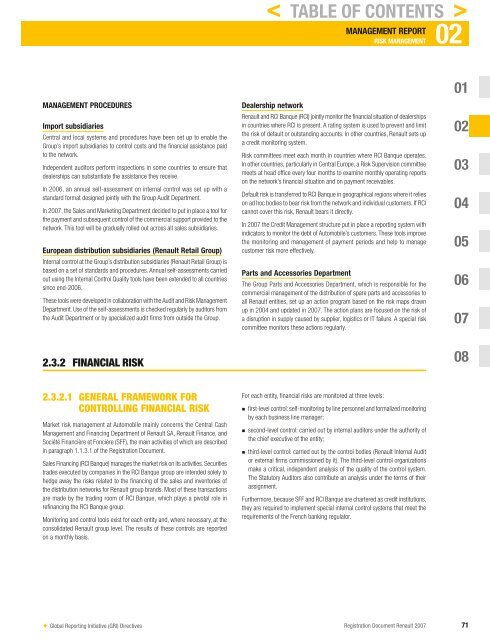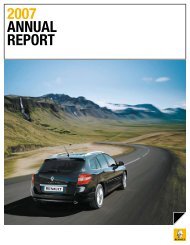2007 Interactive Registration Document - Renault
2007 Interactive Registration Document - Renault
2007 Interactive Registration Document - Renault
Create successful ePaper yourself
Turn your PDF publications into a flip-book with our unique Google optimized e-Paper software.
MANAGEMENT PROCEDURES<br />
Import subsidiaries<br />
Central and local systems and procedures have been set up to enable the<br />
Group’s import subsidiaries to control costs and the fi nancial assistance paid<br />
to the network.<br />
Independent auditors perform inspections in some countries to ensure that<br />
dealerships can substantiate the assistance they receive.<br />
In 2006, an annual self-assessment on internal control was set up with a<br />
standard format designed jointly with the Group Audit Department.<br />
In <strong>2007</strong>, the Sales and Marketing Department decided to put in place a tool for<br />
the payment and subsequent control of the commercial support provided to the<br />
network. This tool will be gradually rolled out across all sales subsidiaries.<br />
European distribution subsidiaries (<strong>Renault</strong> Retail Group)<br />
Internal control at the Group’s distribution subsidiaries (<strong>Renault</strong> Retail Group) is<br />
based on a set of standards and procedures. Annual self-assessments carried<br />
out using the Internal Control Quality tools have been extended to all countries<br />
since end-2006.<br />
These tools were developed in collaboration with the Audit and Risk Management<br />
Department. Use of the self-assessments is checked regularly by auditors from<br />
the Audit Department or by specialized audit fi rms from outside the Group.<br />
2.3.2 FINANCIAL RISK<br />
2.3.2.1 GENERAL FRAMEWORK FOR<br />
CONTROLLING FINANCIAL RISK<br />
Market risk management at Automobile mainly concerns the Central Cash<br />
Management and Financing Department of <strong>Renault</strong> SA, <strong>Renault</strong> Finance, and<br />
Société Financière et Foncière (SFF), the main activities of which are described<br />
in paragraph 1.1.3.1 of the <strong>Registration</strong> <strong>Document</strong>.<br />
Sales Financing (RCI Banque) manages the market risk on its activities. Securities<br />
trades executed by companies in the RCI Banque group are intended solely to<br />
hedge away the risks related to the fi nancing of the sales and inventories of<br />
the distribution networks for <strong>Renault</strong> group brands. Most of these transactions<br />
are made by the trading room of RCI Banque, which plays a pivotal role in<br />
refi nancing the RCI Banque group.<br />
Monitoring and control tools exist for each entity and, where necessary, at the<br />
consolidated <strong>Renault</strong> group level. The results of these controls are reported<br />
on a monthly basis.<br />
✦ Global Reporting Initiative (GRI) Directives<br />
MANAGEMENT REPORT 02<br />
RISK MANAGEMENT<br />
Dealership network<br />
<strong>Renault</strong> and RCI Banque (RCI) jointly monitor the fi nancial situation of dealerships<br />
in countries where RCI is present. A rating system is used to prevent and limit<br />
the risk of default or outstanding accounts. In other countries, <strong>Renault</strong> sets up<br />
a credit monitoring system.<br />
Risk committees meet each month in countries where RCI Banque operates.<br />
In other countries, particularly in Central Europe, a Risk Supervision committee<br />
meets at head offi ce every four months to examine monthly operating reports<br />
on the network’s fi nancial situation and on payment receivables.<br />
Default risk is transferred to RCI Banque in geographical regions where it relies<br />
on ad hoc bodies to bear risk from the network and individual customers. If RCI<br />
cannot cover this risk, <strong>Renault</strong> bears it directly.<br />
In <strong>2007</strong> the Credit Management structure put in place a reporting system with<br />
indicators to monitor the debt of Automobile’s customers. These tools improve<br />
the monitoring and management of payment periods and help to manage<br />
customer risk more effectively.<br />
Parts and Accessories Department<br />
The Group Parts and Accessories Department, which is responsible for the<br />
commercial management of the distribution of spare parts and accessories to<br />
all <strong>Renault</strong> entities, set up an action program based on the risk maps drawn<br />
up in 2004 and updated in <strong>2007</strong>. The action plans are focused on the risk of<br />
a disruption in supply caused by supplier, logistics or IT failure. A special risk<br />
committee monitors these actions regularly.<br />
For each entity, fi nancial risks are monitored at three levels:<br />
n<br />
n<br />
n<br />
< TABLE OF CONTENTS ><br />
fi rst-level control: self-monitoring by line personnel and formalized monitoring<br />
by each business line manager;<br />
second-level control: carried out by internal auditors under the authority of<br />
the chief executive of the entity;<br />
third-level control: carried out by the control bodies (<strong>Renault</strong> Internal Audit<br />
or external fi rms commissioned by it). The third-level control organizations<br />
make a critical, independent analysis of the quality of the control system.<br />
The Statutory Auditors also contribute an analysis under the terms of their<br />
assignment.<br />
Furthermore, because SFF and RCI Banque are chartered as credit institutions,<br />
they are required to implement special internal control systems that meet the<br />
requirements of the French banking regulator.<br />
01<br />
02<br />
03<br />
04<br />
05<br />
06<br />
07<br />
08<br />
<strong>Registration</strong> <strong>Document</strong> <strong>Renault</strong> <strong>2007</strong> 71




